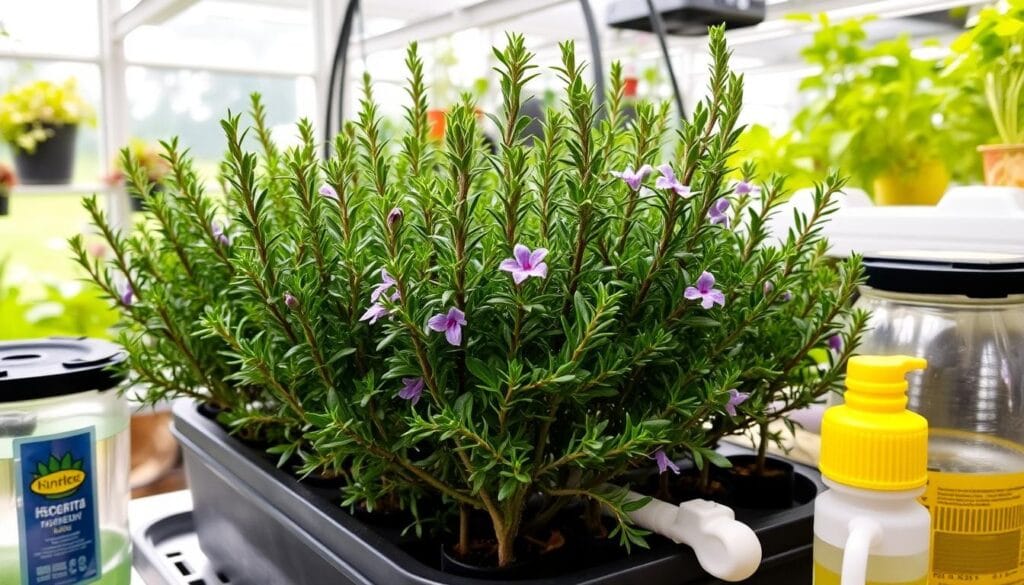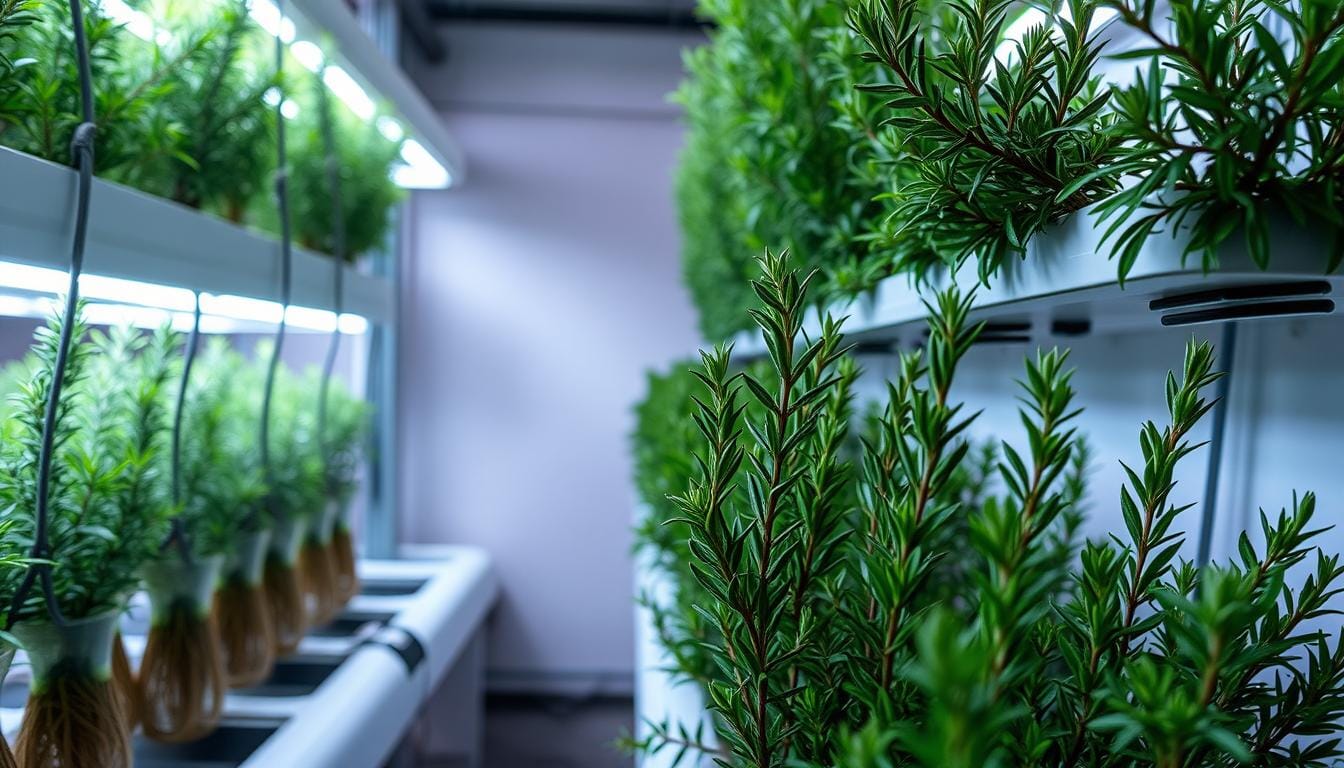Ever wondered how to turn your indoor herb garden into a lush paradise? Growing rosemary in hydroponics is more than a gardening trick. It’s a way to have fresh herbs all year, making your cooking better and bringing nature indoors.
Indoor rosemary growing has changed how we grow herbs. Hydroponic herb gardening is perfect for city gardeners. It uses less water and space and helps plants grow better.
Learning to grow rosemary in hydroponics opens up a world of fresh herbs. These four strategies will make your indoor gardening better. They’ll turn even small spaces into lush herb gardens.
Key Takeaways
- Hydroponics enables year-round rosemary cultivation in compact spaces
- Accurate environmental management promotes faster and healthier growth of herbs
- Minimal water usage compared to traditional gardening methods
- Optimal lighting and nutrient management are key to success
- Indoor herb gardening gives you fresh ingredients right at your fingertips
Understanding Rosemary: Essential Characteristics and Benefits
Rosemary is a special herb from the Mediterranean. It has a unique piney smell and needle-like leaves. This makes it great for growing in hydroponic systems.
Culinary and Medicinal Properties
Using rosemary in your hydroponics can add amazing flavor and health benefits. It has a strong, earthy taste that makes many dishes better. Chefs love it for boosting Mediterranean and European dishes.
- Intense flavor profile perfect for roasted meats
- Excellent in marinades and herb blends
- Rich in antioxidant compounds
- Traditional medicinal herb with multiple health benefits
Growth Requirements and Natural Habitat
To grow rosemary well in hydroponics, you need to know what it likes. It comes from the Mediterranean and has certain environmental needs.
| Growing Parameter | Optimal Conditions |
|---|---|
| Temperature Range | 65°F to 75°F (18°C to 24°C) |
| Light Exposure | 8-12 hours direct sunlight |
| pH Preference | 6.0 – 6.5 |
Health Benefits of Hydroponic Rosemary
Hydroponic rosemary is more than just a flavor enhancer. Scientific research shows it can help with brain function and digestion.
“Rosemary is more than just an herb; it is a potent natural remedy with a long history of traditional medicinal applications.” – Herbal Medicine Researcher
- Supports brain health
- Reduces inflammation
- Improves digestion
- Boosts immune system
With a well-planned rosemary hydroponics system, you can have fresh herbs all year. They grow fast and are good for the planet.
The Science Behind Hydroponic Rosemary Cultivation
Hydroponic gardening is a new way to grow plants, perfect for beginners. It’s exciting to see how rosemary grows in a hydroponic system. The science behind it is very precise.
In a hydroponic setup, rosemary roots get nutrients from a water solution. This is different from growing in soil. This method has many benefits:
- Precise nutrient control
- Constant oxygen access for roots
- Faster growth
- Less risk of soil-borne diseases
Hydroponics is great for beginners because it creates the best growing conditions. Water carries essential nutrients to the plants. This lets them grow faster without worrying about finding food.
“Hydroponics shifts plant cultivation from a trial-and-error approach to a reliable scientific method.” – Agricultural Innovation Research
Hydroponic gardens are very efficient. They require 90% less water compared to traditional farming methods. And they grow crops in half the time. For rosemary, this means faster harvests and healthier plants.
The controlled environment of a hydroponic system helps plants grow better. Without soil, they don’t face pests or mineral problems. You can manage nutrients, pH levels, and conditions for your rosemary to thrive.
Setting Up Your Hydroponic System for Rosemary
Starting your rosemary hydroponics system needs careful planning and the right tools. For those new to hydroponics, picking the right setup is key to growing herbs well.
Choosing the Right Hydroponic Method
There are two main ways to grow rosemary hydroponically:
- Deep Water Culture (DWC): Great for beginners
- Nutrient Film Technique (NFT): Best for those with more experience
Essential Equipment and Materials
Your rosemary hydroponic system needs certain parts:
- Reservoir tank
- Air pump for oxygen
- Grow lights (LED is best)
- Net pots
- Growing medium
“Success in hydroponic gardening starts with knowing your system’s needs.” – Hydroponic Expert.
System Assembly Guidelines
When setting up your rosemary hydroponics system, remember these important points:
- Make sure everything is sealed well to avoid leaks
- Keep the nutrient solution at the right level
- Ensure good aeration
- Check the pH levels, aiming for 5.5 to 6.5
For those new to it, begin on a small scale and gain experience gradually. Rosemary does well in systems with 12 to 16 hours of light a day and temperatures between 65°F to 75°F.
Grow Rosemary in Hydroponics: Step-by-Step Guide

Starting to grow rosemary indoors needs careful planning and precision. Hydroponics is a new way to grow this fragrant herb efficiently.
To grow rosemary in hydroponics, follow these key steps:
- Select High-Quality Cuttings
- Choose healthy rosemary stems
- Remove bottom leaves
- Ensure cutting length of 4-6 inches
- Prepare Rooting Medium
- Use Rockwool cubes
- Maintain consistent moisture
- Keep temperature between 65-75°F
- Transfer to Hydroponic System
- Wait for root development
- Gently transplant into chosen hydroponic setup
- Ensure proper nutrient solution
“Successful hydroponic rosemary cultivation is about creating the perfect environment for growth.” – Herb Cultivation Expert
Your journey to grow indoor rosemary needs to focus on key factors. Lighting, temperature, and nutrient balance are critical. LED grow lights, 6-12 inches above, offer the right spectrum for growth.
Hydroponics can make rosemary grow up to 30% faster than soil. By controlling the environment, you create a perfect spot for your herb.
Optimal Nutrient Solutions for Hydroponic Rosemary
Growing rosemary hydroponically needs a balanced nutrient solution for healthy plants. Knowing what nutrients rosemary needs can make your hydroponic growth better.
pH and EC Management for Rosemary Growth Requirements
Rosemary plants do best in a slightly acidic pH, between 5.5 and 6.5. This helps them absorb nutrients well. The electrical conductivity (EC) should range from 1.2 to 1.6 mS/cm.
Essential Nutrients and Their Roles
- Nitrogen: Supports leaf growth and overall plant vigor
- Phosphorus: Enhances root development and flowering
- Potassium: Improves plant resistance and metabolic processes
- Calcium: Strengthens cell walls and supports root growth
- Magnesium: Critical for chlorophyll production
Solution Maintenance Schedule
Your rosemary nutrient solution needs regular care. Change the solution every 7-14 days to keep plants healthy.
| Nutrient Aspect | Recommended Practice |
|---|---|
| Solution Change Frequency | Every 7-14 days |
| Water Top-up | As needed to maintain proper levels |
| EC Level | 1.2-1.6 mS/cm |
| pH Range | 5.5-6.5 |
Pro tip: Always use a balanced hydroponic nutrient solution designed for herbs to ensure optimal rosemary growth requirements.
Regular checks and precise nutrient control will help you grow healthy, fragrant rosemary in your hydroponic system.
Light Requirements and Environmental Control
Creating the perfect environment is key for growing indoor rosemary. This Mediterranean herb needs specific light and temperature to grow well. So, controlling these factors is vital for its health.
For your hydroponic rosemary, pay close attention to these environmental factors:
- Direct sunlight exposure of 6-8 hours daily
- Full-spectrum LED grow lights with 3000K-5000K color temperature
- Consistent room temperatures between 65-75°F (18-24°C)
- Humidity levels maintained at 40-60%
Light is essential for rosemary’s growth. Positioning grow lights 6-12 inches above your plants ensures optimal light absorption. LED lights are great because they use less energy and provide steady light.
“The right light can transform your indoor herb garden from surviving to thriving.” – Hydroponic Gardening Expert
Here are some tips for setting up your indoor rosemary environment:
- Use reflective surfaces to maximize light distribution
- Implement a consistent 12-16 hour light cycle
- Monitor light intensity and adjust as needed
- Rotate plants to ensure even light exposure
Good air circulation is important to prevent fungal diseases and promote strong growth. A small oscillating fan can help keep the air moving, just like the Mediterranean breezes.
Propagation Techniques for Hydroponic Rosemary
Learning how to propagate rosemary is key to growing it well in hydroponics. Whether you’re new to hydroponics or have experience, knowing the right methods is important. It helps you grow healthy, vibrant rosemary plants.
Selecting the Perfect Cuttings
Choosing the right cuttings is the first step in growing hydroponic rosemary. Look for stems that are:
- 4-6 inches long
- Free from flowers
- Healthy, without disease or pests
- Taken from strong, mature plants
Rooting Your Rosemary Cuttings
Getting your cuttings to root is essential for growing hydroponic rosemary. Here’s a simple guide for beginners:
- Remove lower leaves from the cutting
- Dip the cut end in rooting hormone
- Put cuttings in Rockwool cubes or perlite
- Keep the area humid (40-60%)
- Use bottom heat if you can
“The secret to successful rosemary propagation lies in patience and precise environmental control.” – Hydroponic Herb Experts.
Rooting Timeline and Transfer
Roots should start to show in 2-3 weeks with the right care. When roots are 1-2 inches long, it’s time to move the plants to your hydroponic system. Keep the temperature between 65°F and 75°F for the best results.
| Propagation Stage | Key Conditions | Duration |
|---|---|---|
| Cutting Preparation | Healthy 4-6 inch stems | Initial selection |
| Rooting Process | High humidity, bottom heat | 2-3 weeks |
| System Transfer | 1-2 inch root development | After rooting |
Managing Common Challenges and Plant Health

Growing rosemary in hydroponic systems needs careful planning to keep plants healthy. Knowing the common problems helps you grow a strong and tasty herb garden.
Controlling pests in hydroponic rosemary is key. Pests like spider mites and aphids can harm your garden. It’s important to use preventive measures to keep plants healthy.
Key Challenges in Hydroponic Rosemary Cultivation
- Preventing root rot by ensuring enough oxygen
- Managing the nutrient solution
- Monitoring and controlling pests with organic methods
- Stopping fungal diseases
To control pests in hydroponic rosemary, manage the environment well. Make sure there’s good airflow and keep the growing area clean. This helps prevent health problems.
Pest Management Strategies
| Pest Type | Organic Control Method | Prevention Technique |
|---|---|---|
| Spider Mites | Neem oil spray | Maintain humidity levels |
| Aphids | Insecticidal soap | Regular plant inspection |
| Fungus Gnats | Beneficial nematodes | Control moisture levels |
“In hydroponic herb gardening, taking preventive measures is always more effective than dealing with problems later.” – Herb Growing Experts.
Regularly check your hydroponic rosemary system to catch problems early. Using these strategies will help you grow a healthy and productive herb garden.
Pruning and Maintenance Strategies
To keep your hydroponic herb garden thriving, you need to prune your rosemary wisely. This care keeps your plants healthy, strong, and full of life. It’s key to their growth.
Proper Trimming Techniques
Here are the main steps for pruning rosemary in your hydroponic setup:
- Cut the top 2-3 inches of each stem just above a leaf node
- Never remove more than one-third of the plant during a single pruning session
- Trim every 6-8 weeks during active growth periods
Growth Management Tips
Good hydroponic herb gardening means managing your plants well. Strategic pruning helps them grow bushy and prevents them from getting too long.
| Pruning Technique | Frequency | Expected Result |
|---|---|---|
| Top Trimming | Every 6-8 weeks | Compact, dense growth |
| Removing Dead Leaves | As needed | Prevent disease spread |
| Rotate Plants | Weekly | Even light distribution |
Regular pruning turns your hydroponic rosemary into a thriving, productive plant.
To keep your hydroponic rosemary healthy, make sure the environment is right. Keep the temperature between 65°F to 75°F. Also, give it 12-16 hours of light every day for the best growth.
Harvesting and Storage Methods
Harvesting your rosemary is the most exciting part of hydroponic herb gardening. Growing rosemary indoors lets you pick fresh herbs right from your garden.
How you harvest your rosemary affects its growth and taste. Here are some tips to get the most from your herb:
- Cut stems 6-8 inches long during morning hours
- Don’t remove more than one-third of the plant in a single trim
- Use clean, sharp pruning shears for precise cuts
- Target mature stems with multiple leaf clusters
Storing your rosemary right is key to keeping it fresh. Fresh-picked sprigs need careful handling to keep their scent. Refrigeration is a great way to keep them fresh:
- Wrap rosemary in slightly damp paper towels
- Place wrapped herbs in a sealed plastic bag
- Store in the refrigerator’s vegetable drawer
- Use within 7-10 days for optimal freshness
“By mastering the art of harvesting and storing, your hydroponic rosemary becomes more than just a gardening venture—it transforms into a culinary gem.” – Herb Cultivation Expert.
Drying rosemary is a great way to keep it for longer. Hang bunches in a warm, dark, well-ventilated area. This method keeps the herb’s flavor strong and lets you enjoy it for months.
Conclusion
Grow rosemary in hydroponics is a new way to garden that changes old methods. It uses smart techniques like exact nutrient control, set environmental conditions, and top-notch lighting. This way, you can grow a healthy rosemary garden that tastes great and has health benefits.
Starting a hydroponic herb garden with rosemary has big benefits. It saves water, grows all year, and keeps plants healthy. You can control everything, making plants strong and full of essential oils. This is way better than growing in soil.
Starting with hydroponics takes money and learning, but it’s worth it. Paying attention to pH, nutrients, and environment helps your rosemary grow best. It’s great for cooking or herbal medicine, making it a smart and green way to grow herbs.
Keep learning and growing with hydroponic gardening. Your hard work will pay off with fresh, fragrant rosemary. It will make your food and health routines even better.

